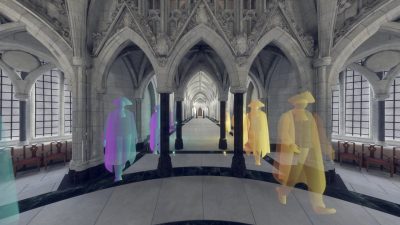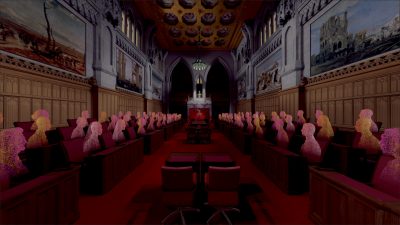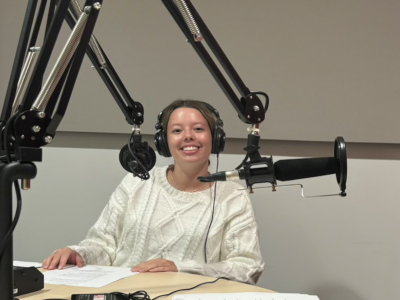
Photo from Library of Parliament/National Film Board of Canada
Standing 29 cm tall with a weight of 2.1 kg is the golden face of the Prix Gémeaux award, honouring the French-language television industry’s achievements in Canada since 1987. New categories for digital media were introduced in 2003 and continues to be expanded as technology changes with new technologies and digital advancements. In 2020, in the category of Meilleure experience interactive: toutes categories, the winning entry was Parlement: L’Expérience en Réalité Virtuelle, a collaborative project led by the Library of Parliament and the National Film Board. The experience is a 15-minute virtual reality journey through the Centre Block of Canada’s main rooms, where the virtual visitor is introduced to the main concepts of Canadian democracy. As the colourful story unfolds in front of the viewer, they stand in the detailed digital model of the Centre Block, created by a team at Carleton Immersive Media Studio (CIMS) led by Katie Graham, Instructor in the Bachelor of Media Production and Design program at Carleton University. Katie Graham and CIMS are proud to be a part of the award-winning project, sharing in its success and achievements.

Photo from Library of Parliament/National Film Board of Canada
Beginning in 2012, CIMS has been heavily involved in the development of a detailed building information model (BIM) of the Parliamentary Precinct. Work has included assisting Heritage Conservation Services (HCS) with the documentation of the West Block, East Block, Centre Block, and grounds with terrestrial laser scanning and photogrammetry; working collaboratively with the Dominion Sculpture, Phil White, on the rehabilitation and creation of ornamental carvings in the original and temporary accommodations of parliamentary activities; and creating a detailed BIM of the existing condition, with a high level of detail for heritage significant spaces. Katie Graham, as a researcher and now associate faculty at CIMS, has had the opportunity to lead digitally assisted storytelling projects, such as the VR Kiosk, the Senate Virtual Tour, and Parliament: A Virtual Experience, that use these assets for communication and dissemination.
Parliament: A Virtual Experience was the largest digitally assisted storytelling project that CIMS and Ms. Graham developed at that time, with a broad scope, diverse set of stakeholders, and a short timeline. The CIMS team converted the existing documentation into a virtual reality compatible space through excellent communication and teamwork in a short seven-month timeline. The interdisciplinary team consisted of undergraduate, graduate, and post-graduate researchers from architecture, engineering, and interactive media design. Each helped develop protocols and workflows to convert the large dataset into a manageable and detailed model. During the project, the team’s biggest challenge was striking a balance between the level of detail of artifacts within the model and ensuring the size of the model remained compatible with virtual reality specifications. A level of detail system was developed by CIMS to increase the detail of model elements deemed significant to the heritage space and the narrative while allowing other parts to be reduced or removed entirely.
Working with the Library of Parliament and the National Film Board proved to be a fantastic opportunity for CIMS and Ms. Graham. The final product was an intricate narrative developed by the creative team that unfolds within the digital space created by CIMS. While the Centre Block remains closed for the next decade for the rehabilitation project, virtual visitors will be able to experience the building like never before. The stone walls and wood carvings have been translated into polygons and texture maps. Still, the architectural impression and the lessons on Canadian democracy have become accessible to a broader audience through its digital conversion.

Photo from Library of Parliament/National Film Board of Canada
Experience the project here.
Thursday, October 15, 2020 in General, Journalism News
Share: Twitter, Facebook



